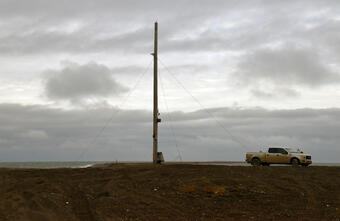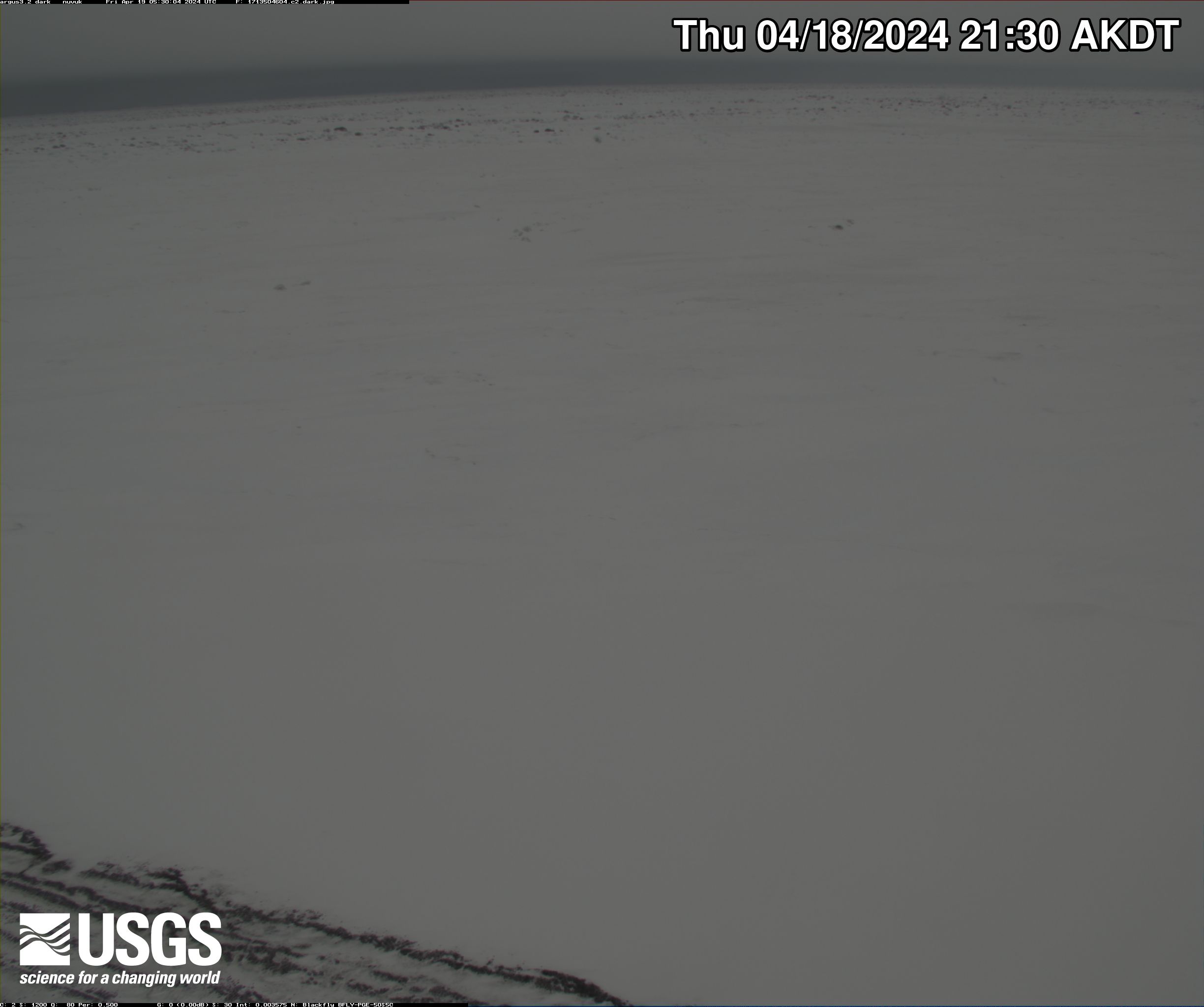Point Barrow, Alaska, or Nuvuk, is the northernmost point in the United States. USGS has set up video cameras, mounted to the pole shown here, to study sediment movement and wave dynamics along this dynamic coastline.
Using Video Imagery to Study Sediment Transport and Wave Dynamics: Nuvuk (Point Barrow)
Two coastal observing video cameras are installed atop a utility pole near the northernmost point of land in the United States, at Nuvuk (Point Barrow), Alaska. The cameras point northwest toward the Arctic Ocean and the boundary between the Chukchi and Beaufort Seas, and will be used to observe and quantify coastal processes such as wave run-up, bluff erosion, movement of sandbars and ice floes, and sediment entrainment and transport by ice.

Nuvuk, Alaska sits at the end of a low-lying barrier spit about 16 km (10 miles) northeast of the Alaska Community of Utqiaġvik (formerly Barrow). This region is vulnerable to coastal erosion and marine flooding during large storm events which are now increasingly impacting the coast during the fall and early winter months. Warming trends in the Arctic are leading to reduced ice coverage and later fall and early winter freeze-up of shorefast ice allowing storm surge and ocean waves to flood and erode the otherwise protected coast.
Every half hour during daylight hours, the cameras collect snapshots and video for 10 minutes. Examples of the types of images collected are shown below. Please note that it takes 10 minutes for the images to be posted, once they are collected by the solar-powered camera. Also note that if an old image is shown, the solar panels may not be getting enough sun and the camera system goes into power-saving mode.
For water level and meteorological observations near the Nuvuk station, visit the Prudhoe Bay NOAA Tides & Currents site.

This is the second USGS coastal observing camera operating in Alaska. The station at Unalakleet Alaska, on the coast of Norton Sound, has been operating since March 2019 (with an extended gap between November 2019 through September 2021). The knowledge gained will improve computer-derived simulations of shoreline change that communities can use to plan for sea-level rise, changing storm patterns, and other threats to coasts.
Currently, USGS video cameras are active at these locations:
- Dream Inn hotel in Santa Cruz, California
- Head of the Meadow Beach, Massachusetts
- Marconi Beach, Massachusetts
- Norton Sound, Unalakleet, Alaska
- Nuvuk (Point Barrow), Alaska
- Sunset State Beach, California
Snapshot
The snapshot is the first frame of the video, just like a standard photo.
Timex (time-exposure) images
A timex is a time-averaged image of all frames, smoothing away surface waves and determining the location of persistent wave-breaking (indicative of shallow sandbars).
Variance images
A “variance” image shows the standard deviation of pixel intensity throughout the video, and it is useful for determining how much variation or movement is occurring at a given location.
Bright images
A “bright” image shows the brightest pixel values throughout the video, useful for identifying the position of maximum wave run-up on the beach, position of all breaking waves, and sea-state.
Dark images
A “dark” image shows the darkest pixel values throughout the video, useful for tracking sediment plumes, tracking floating debris, and filtering out breaking waves.

Below are other science projects associated with this project.
Remote Sensing Coastal Change
Climate impacts to Arctic coasts
Using Video Imagery to Study Coastal Change: Santa Cruz Beaches
Using Video Imagery to Study Coastal Change: Sunset State Beach
Using Video Imagery to Study Wave Dynamics: Unalakleet
Using Video Imagery to Study Marconi Beach
Below are multimedia items associated with this project.
Point Barrow, Alaska, or Nuvuk, is the northernmost point in the United States. USGS has set up video cameras, mounted to the pole shown here, to study sediment movement and wave dynamics along this dynamic coastline.
Point Barrow, Alaska, or Nuvuk, is the northernmost point in the United States. USGS has set up video cameras, mounted to the pole shown here, to study sediment movement and wave dynamics along this dynamic coastline.
Point Barrow, Alaska, or Nuvuk, is the northernmost point in the United States. USGS has set up video cameras, mounted to the pole shown here, to study sediment movement and wave dynamics along this dynamic coastline.
Two coastal observing video cameras are installed atop a utility pole near the northernmost point of land in the United States, at Nuvuk (Point Barrow), Alaska. The cameras point northwest toward the Arctic Ocean and the boundary between the Chukchi and Beaufort Seas, and will be used to observe and quantify coastal processes such as wave run-up, bluff erosion, movement of sandbars and ice floes, and sediment entrainment and transport by ice.

Nuvuk, Alaska sits at the end of a low-lying barrier spit about 16 km (10 miles) northeast of the Alaska Community of Utqiaġvik (formerly Barrow). This region is vulnerable to coastal erosion and marine flooding during large storm events which are now increasingly impacting the coast during the fall and early winter months. Warming trends in the Arctic are leading to reduced ice coverage and later fall and early winter freeze-up of shorefast ice allowing storm surge and ocean waves to flood and erode the otherwise protected coast.
Every half hour during daylight hours, the cameras collect snapshots and video for 10 minutes. Examples of the types of images collected are shown below. Please note that it takes 10 minutes for the images to be posted, once they are collected by the solar-powered camera. Also note that if an old image is shown, the solar panels may not be getting enough sun and the camera system goes into power-saving mode.
For water level and meteorological observations near the Nuvuk station, visit the Prudhoe Bay NOAA Tides & Currents site.

This is the second USGS coastal observing camera operating in Alaska. The station at Unalakleet Alaska, on the coast of Norton Sound, has been operating since March 2019 (with an extended gap between November 2019 through September 2021). The knowledge gained will improve computer-derived simulations of shoreline change that communities can use to plan for sea-level rise, changing storm patterns, and other threats to coasts.
Currently, USGS video cameras are active at these locations:
- Dream Inn hotel in Santa Cruz, California
- Head of the Meadow Beach, Massachusetts
- Marconi Beach, Massachusetts
- Norton Sound, Unalakleet, Alaska
- Nuvuk (Point Barrow), Alaska
- Sunset State Beach, California
Snapshot
The snapshot is the first frame of the video, just like a standard photo.
Timex (time-exposure) images
A timex is a time-averaged image of all frames, smoothing away surface waves and determining the location of persistent wave-breaking (indicative of shallow sandbars).
Variance images
A “variance” image shows the standard deviation of pixel intensity throughout the video, and it is useful for determining how much variation or movement is occurring at a given location.
Bright images
A “bright” image shows the brightest pixel values throughout the video, useful for identifying the position of maximum wave run-up on the beach, position of all breaking waves, and sea-state.
Dark images
A “dark” image shows the darkest pixel values throughout the video, useful for tracking sediment plumes, tracking floating debris, and filtering out breaking waves.

Below are other science projects associated with this project.
Remote Sensing Coastal Change
Climate impacts to Arctic coasts
Using Video Imagery to Study Coastal Change: Santa Cruz Beaches
Using Video Imagery to Study Coastal Change: Sunset State Beach
Using Video Imagery to Study Wave Dynamics: Unalakleet
Using Video Imagery to Study Marconi Beach
Below are multimedia items associated with this project.
Point Barrow, Alaska, or Nuvuk, is the northernmost point in the United States. USGS has set up video cameras, mounted to the pole shown here, to study sediment movement and wave dynamics along this dynamic coastline.
Point Barrow, Alaska, or Nuvuk, is the northernmost point in the United States. USGS has set up video cameras, mounted to the pole shown here, to study sediment movement and wave dynamics along this dynamic coastline.
Point Barrow, Alaska, or Nuvuk, is the northernmost point in the United States. USGS has set up video cameras, mounted to the pole shown here, to study sediment movement and wave dynamics along this dynamic coastline.
Point Barrow, Alaska, or Nuvuk, is the northernmost point in the United States. USGS has set up video cameras, mounted to the pole shown here, to study sediment movement and wave dynamics along this dynamic coastline.



















